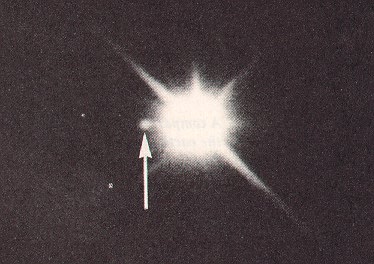During a star's life it produces heat and energy through nuclear fusion.
Protons that were in the star from the time it was created fuse with other
protons to produce a nucleus called Hydrogen-2
and these nuclei fuse together to make Helium-3
and another two of these nuclei fuse together to make Helium-4
and two protons. Everytime nuclei is fused, it releases energy in
the form of light and heat because of a theory called energy
of mass. This energy is produced through fusing of nuclei trillions
and trillions of times per second every day and every year for millions
and millions of years. Since under normal circumstances, protons
will not fuse, immense heat and pressure inside the core of a star forces
protons and nuclei together deep within the center of the star where temperatures
will reach beyond 60 million degrees Fahrenheit. As the energy
of mass in these particles are being converted to rapidly moving particles
that produce heat which in turn produces light (energy
of motion), the rapidly moving particles colide with each other and
cause each other to vibrate and produce heat and light. Since particles
are more concentrated at the center of the star, the particles collide
more violently and move much faster so there is a lot more heat.
As the moving particles move closer to the surface of the star, the particles
are less concentrated so the collision lessens and so does the heat.
The nuclear fusion exhibited in stars is also present in hydrogen bombs
or fusion bombs although far weaker in the bombs. The bombs use the
same principle to fuse hydrogen nuclei into helium nuclei releasing tremendous
amounts of energy that is capable of destroying cities. But why then
doesn't the sun in our solar system destroy the Earth since the process
inside a hydrogen bomb is repeated a trillion times over inside the sun?
Well, the sun like all other stars have a protective layer above the core
composed of blankets of matter that, in total, weigh about 330,000 times
as much as the Earth and control the output of energy.
Of course, the star has a limited amount of protons and nuclei and will
eventually run out. When all the protons inside the core are exhausted,
the star will move on to the layer outside the core and fuse those protons.
When all the layers are out of protons the star will look for a more desperate
way of producing energy, the fusing of the helium nuclei to create carbon
nuclei. Although this also produces energy in the form of light and
heat, the energy released isn't as strong and the energy
of motion - that counteracts the star's gravitational pull that would
otherwise cause the star to contract - produced from the energy
of mass isn't as strong either so the star's self gravitation causes
it to contract. The fusion of helium nuclei requires far higher temperatures
than 60 million degrees Fahrenheit since helium nuclei with positive charges
repel each other even stronger than protons do. Thus, the temperatures
in the core of a star will reach up to 300 million degrees Fahrenheit.
Hundreds of millions of years after this has happened the helium nuclei
will also be exhausted and the star is left with carbon nuclei. This
carbon nuclei does not fuse together however, but rather the star stops
its production of energy and its own gravitation takes over. Since
there is no longer any energy
of motion produced by fusion to hold it together, the star contracts
and becomes extremely small and dense such that its volume is about the
size of the earth's and it's mass is the weight of the sun's. This
white dwarf has
a density about a million times that of water. A teaspoonful of white
dwarf material, if brought to earth, would weigh a ton! But what
keeps this white dwarf from contracting even further into perhaps a grape-sized
planet? The reason for this is what we call the exclusion
principle. The exclusion
principle states that certain particles - in this case electrons -
will not be packed past a certain critical density. So the electrons
in the white dwarf keep it from contracting even further. Larger
stars end their lives more gloriously than those that become white dwarves.
These stars, at the end of their lives are solely composed of neutrons
which are able to be packed into a larger density than electrons allowing
them to be far smaller than white dwarves and their gravitational pull
on their surface much stronger. That leads us to the next subject
"Neutron Stars and Supernovas."

A photograph of the white
dwarf ( the one the arrow
is pointing to)
Sirius B in a mutli-star solar system.


